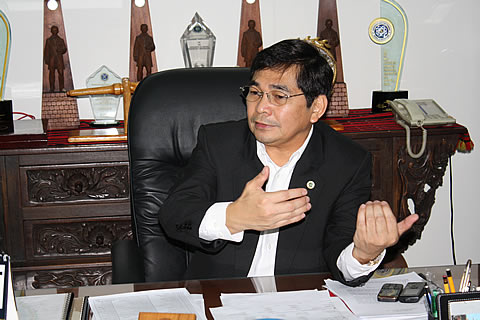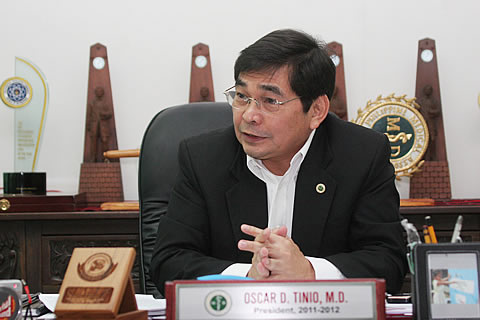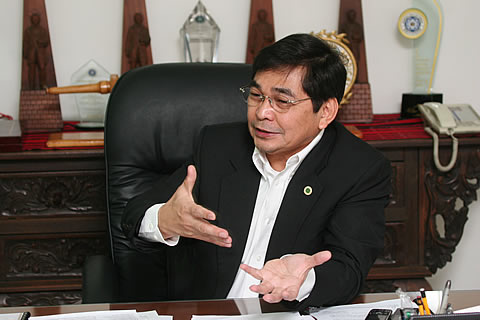PhilHealth
home | contact us | sitemap | disclaimer
News
PhilHealth and PMA:
'You can’t have one without the other.'
May 30, 2012
This line from Frank Sinatra’s classic rendition of ‘Love and Marriage’ describes how the Philippine Health Insurance Corporation (PhilHealth) and the Philippine Medical Association (PMA) have been working together for years to make health care available and affordable to each and every Filipino. One ensures access, the other delivers the services.
This long-standing linkage is constantly challenged by developments in the local health care industry within which PhilHealth and the PMA operate. But these challenges all the more strengthened both organizations’ trust and confidence in each other, and the lessons learned have enabled both to withstand the pressures that come with making quality health care within reach of every Filipino family.
We sat down with PMA President Dr. Oscar D. Tinio recently to get his insights on various aspects affecting the medical profession. Asked to describe the current state of relationship between PhilHealth and PMA, Tinio said: Dapat magandang samahan ‘yan because we are the implementors of the health care system. We have to work with government, and the private sector will have to contribute largely to the health care delivery system because the government cannot provide everything. Technically, dapat nagtatrabaho tayo together. Ano’ng ginagawa ng PMA for PhilHealth? accreditation, peer review, yung mga clinical practice guidelines... they all come from the PMA, from the specialty societies of the PMA.
Consultation, not just information
In terms of policy formulation and implementation, Tinio emphasized the need for the PMA to contribute equally to the development of PhilHealth policies affecting physicians and the health insurance system in general. “Let us be a part of it because we are very much a part of it. Let us know what to do, kausapin n’yo kami.” He was vocal about the case rates experience for which he claims the PMA was not consulted prior to implementation, saying they were merely informed about the new policy. “I’ve been President (of the PMA) for the past two years, it was implemented September last year, dapat alam ko ‘yan even during the formative processes and stages...”
It was this stakeholder sentiment on the case rates that thrust PhilHealth into the limelight late last year. But Tinio urged the PMA membership to give the new system a chance. “There was a promise that after six months there will be a review. We have to sit down and look at what goes on in the review,” he said, adding that the PMA, along with the Philippine Hospital Association (PHA) and the Private Hospitals Association of the Philippines (PHAP), have already submitted a position paper to PhilHealth recommending certain important changes in the case rate system. (Update: improvements in the case rates are expected to be discussed in the June 2012 board meetings of PhilHealth)
The case payment scheme is a provider payment method that reimburses a predetermined fixed rate for each treated case. The case rate amount is inclusive of hospital charges and professional fees (PF) of attending physicians. For medical conditions, 30% of the case rate amount goes to doctor’s PF; for surgical procedures, 40% goes to the doctor’s PF. While doctors generally posed no objections to this distribution, there are concerns on how the percentage amount will be divided among multiple doctors attending to a single patient. “But that is outside of PhilHealth now, it’s actually between us and the hospital,” Tinio said.
Special consideration for specialists
Apart from the case rates, PhilHealth also pays for other causes of confinements of its members through the fee-for-service mode, under which a two-tiered approach to remunerating physician’s services is observed. “It encourages the doctors to become specialists,” Tinio noted, but he laments the fact that the preferential consideration for specialists was apparently not considered under the case rate scheme. “Why is it that we no longer have the premium of being specialists when we provide for better service to our patients?”. He pointed out that what the doctors would like is for PhilHealth to recognize that there should still be a corresponding premium for the specialist. “You must give additional incentives and premiums to specialists, otherwise, bakit pa?”
More avenues to engage doctors
Tinio believes that if PhilHealth is really bent on achieving its goal of universal health coverage, it has to look for other avenues to engage more doctors. For instance, he said, an automatic recognition by PhilHealth of doctors duly certified by the PMA will significantly boost the current number of participating doctors from 22,000 to 70,000 which is the total membership count of the PMA. But how can PhilHealth be assured that these doctors are qualified? “The PMA is there to maintain the competency of doctors. We make sure that the practice of medicine in the country is at its acceptable competency level in all specialties,” he said. The same is true for specialty organizations that might be interested in gaining PhilHealth’s recognition.“Ang specialties lamang na dapat tanggapin ng PhilHealth ay yung ie-endorse ng PMA. They have to go through the PMA for endorsement to PhilHealth,” he asserts. (Update: PMA and PhilHealth signed a MOU delegating to PMA the accreditation of doctors last May 14, 2012)
As the mother organization of licensed doctors in the country, the PMA’s network includes 118 component societies, eight specialty divisions, about 57 specialty groups and another 35 or so affiliate societies nationwide. By the sheer number of member-physicians that it has today, there is no doubt that the PMA is the biggest medical association, and probably the oldest existing at over a hundred years already. If anything, this large number debunks claims that the country lacks doctors. “Hindi kulang ang doctors, we are within the WHO ratio of one is to 10,000,” Tinio shared, adding that the problem is that these doctors are maldistributed. Most of these doctors, Tinio observed, are in the urban centers where opportunities are, that is why the public perceives a lack of medical practitioners in the country. But he salutes doctors who have truly made it their vow to serve, never mind if they receive poultry, rice, bananas and other farm produce in exchange for their services.
Tapping doctors for PCB1 Package
Tinio also believes that the PMA and other specialty societies can work closely with PhilHealth in the implementation of the Primary Care Benefit I (PCB1) Package. He suggests that PhilHealth tap the PMA database to identify where the doctors are actually situated. “I-map yung doctors, i-map yung pasyente…bawat isang doctor may assignment na families na aalagaan niya for an entire year,” he said. In essence, the family becomes the doctor’s responsibility where their primary care is concerned.
He remains optimistic that the arrangement can be done. For instance, he said, the Philippine Academy of Family Physicians (PAFP) which his wife Christine heads, can also support the PCB1 implementation. “Wala akong nakikitang pinakamagandang group of doctors who can implement this strategy than the PAFP. While everybody can do primary care, there are doctors who are more qualified to do it,” he said. (Update: PCB1 became effective April 1, 2012)
He acknowledges that a lot of work still has to be done to further improve on the relationship between PMA and PhilHealth. “Let’s work this thing out. Let’s have a mutually satisfying partnership because this is the only way to go. If you want to help majority of the people, and all of us will participate, then there is no organization that can do this better except the PMA,” he said. This Novo Ecijano who specializes in occupational medicine, has high hopes that when he steps down as PMA President by month-end, whoever takes the reins of the PMA, “will continue the things that we have started.”
He supports PhilHealth President and CEO Dr. Eduardo P. Banzon’s efforts to introduce better systems to make sure that PhilHealth delivers on its promise. He shares that with Banzon, “we agree on a lot of matters,” but that if they tend to disagree, “there should be a meeting point somewhere where we can both be winners.”
Sinatra was right after all. With PhilHealth and the PMA, ‘you can’t have none, you can’t have one without the other.’ (by Maria Sophia B. Varlez; photos by Juanito G. Pineda)


